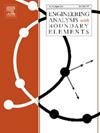Quadratic time elements for time-dependent fundamental solution in the BEM for heat transfer modeling
IF 4.2
2区 工程技术
Q1 ENGINEERING, MULTIDISCIPLINARY
Engineering Analysis with Boundary Elements
Pub Date : 2024-11-01
DOI:10.1016/j.enganabound.2024.106008
引用次数: 0
Abstract
In this paper, a quadratic time interpolation for temperature and a linear time interpolation for fluxes are implemented for the parabolic (time-dependent) fundamental solution-based scheme for solving transient heat transfer problems with sources using the subdomain BEM (boundary element method), which is the main innovation of this paper. The approach described in this work to incorporate the quadratic time variation does not require doubling the number of equations, which is otherwise required in the BEM literature, for the discretized problem to be well-conditioned. Moreover, the numerical accuracy, compared over an unprecedented range of the Fourier number (Fo) and source strength values, can help in selecting the appropriate scheme for a given application, depending on the rate of the heat transfer process and the included source term. The newly implemented scheme based on the parabolic fundamental solution is compared with the well-established elliptic (Laplace) scheme, where the time derivative of the temperature is approximated with the second-order finite difference scheme, on two examples.
用于传热建模 BEM 中时间相关基本解的二次时间元素
本文采用子域 BEM(边界元法)的抛物线(随时间变化)基本解法,对温度进行二次时间插值,对流量进行线性时间插值,用于求解有源的瞬态传热问题,这是本文的主要创新之处。本文所描述的纳入二次时间变化的方法不需要像 BEM 文献中所要求的那样将方程数量增加一倍,就能对离散化问题进行良好调节。此外,在前所未有的傅立叶数(Fo)和源强度值范围内比较数值精度,有助于根据传热过程的速率和所包含的源项,为特定应用选择合适的方案。在两个示例中,将基于抛物线基本解的新实施方案与成熟的椭圆(拉普拉斯)方案进行了比较,后者使用二阶有限差分方案对温度的时间导数进行近似。
本文章由计算机程序翻译,如有差异,请以英文原文为准。
求助全文
约1分钟内获得全文
求助全文
来源期刊

Engineering Analysis with Boundary Elements
工程技术-工程:综合
CiteScore
5.50
自引率
18.20%
发文量
368
审稿时长
56 days
期刊介绍:
This journal is specifically dedicated to the dissemination of the latest developments of new engineering analysis techniques using boundary elements and other mesh reduction methods.
Boundary element (BEM) and mesh reduction methods (MRM) are very active areas of research with the techniques being applied to solve increasingly complex problems. The journal stresses the importance of these applications as well as their computational aspects, reliability and robustness.
The main criteria for publication will be the originality of the work being reported, its potential usefulness and applications of the methods to new fields.
In addition to regular issues, the journal publishes a series of special issues dealing with specific areas of current research.
The journal has, for many years, provided a channel of communication between academics and industrial researchers working in mesh reduction methods
Fields Covered:
• Boundary Element Methods (BEM)
• Mesh Reduction Methods (MRM)
• Meshless Methods
• Integral Equations
• Applications of BEM/MRM in Engineering
• Numerical Methods related to BEM/MRM
• Computational Techniques
• Combination of Different Methods
• Advanced Formulations.
 求助内容:
求助内容: 应助结果提醒方式:
应助结果提醒方式:


